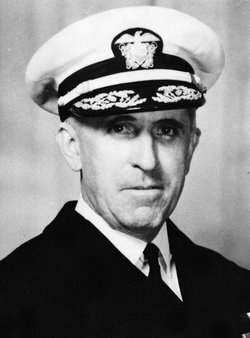Rear Admiral Herbert F. Leary, USN, erstwhile Commander, Cruisers Battle Force (ComCruBatFor), came aboard Chicago at 1046 hours on January 29, 1942 for duty as the Commander of Task Force 2 (ComTaskFor 2). The admiral would soon be promoted to vice admiral and command of the ANZAC Force.

Leary didn’t linger, as he and some of his staff left the ship the same day, in order to head to the ANZAC area, with the first stop by air to be Wellington, New Zealand.
The ANZAC Area (aka ANZAC Command) was an Allied area of operations to the north and east of Australia which was established by the Allied Combined Chiefs of Staff on January 29, 1942, after the fall of Singapore and Rabaul.

At the same time, the companion American-British-Dutch-Australian (ABDA) Command was already defending the Malay Barrier to the north and west of Australia. The primary purpose of the ANZAC Command was to protect Australia’s northeastern approaches and defend the sea and air lines of communication between Australia and the United States.

Forces allocated to the ANZAC Command were naval and air, as the command was not made responsible for defense of the Australian landmass. Naval forces originally tasked were the carrier Hermes from Great Britain, the US to provide either a heavy (CA-type) or modern light cruiser (e.g., Brooklyn-class CL) and two destroyers, Australia was to provide two heavy cruisers, a light cruiser, three armed merchant cruisers , two destroyers, two anti-submarine patrol vessels and six corvettes, New Zealand was to provide two light cruisers and an armed merchant cruiser.
As things turned out, the British retained HMS Hermes in the Indian Ocean, along with her 20 Swordfish and Fulmar aircraft. A squadron of USAAF B-17 Flying Fortress heavy bombers, which came to be known as the Kangaroo Squadron, deployed to the South Pacific and operated in the ANZAC area under naval command, first from Fiji and then out of Townsville, Australia.

With Chicago now under orders to join the ANZAC Force, Captain Bode assumed command of Task Group 2.2, which consisted of USS Chicago (CA-29) and a pair of Mahan-class destroyers, USS Lamson (DD-367) and USS Perkins (DD-377) – Lamson was already in Samoa are on detached duty.

Chicago was perhaps chosen as she was built as a fleet flagship and offered suitable flag officer and staff facilities for use by Admiral Leary, as seen in her days as the flagship for the Commander, Cruisers, Scouting Force. Leary, however, emulating the former Pacific Fleet Commander Admiral Husband Kimmel, decided the best way to command and control his area of operations was not from a flagship but from a headquarters ashore. That way the flagship’s position would not be compromised by the necessary radio communications needed to exercise command and control naval forces.

On February 2, the American contingent of the ANZAC naval squadron, TG 2.2, got underway from Pearl Harbor at 1059 hours and proceeded to join the ANZAC Squadron of the ANZAC Force in the ANZAC area of operations.